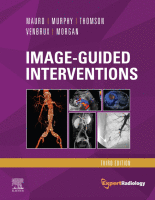Physical Address
304 North Cardinal St.
Dorchester Center, MA 02124

Clinical Relevance Embolotherapy of the renal arteries was introduced into the portfolio of the interventional radiologist many years ago. It was most popular in the 1980s and 1990s when preoperative embolization of kidneys containing a renal cell carcinoma (hypernephroma) was…

Acute renal ischemia occurs because of a transient sudden drop in the total or regional blood flow to the kidney. Acutely diminished renal perfusion results in acute kidney injury. Impaired blood flow to both kidneys or to a solitary functional…

Acknowledgments The authors wish to acknowledge the contributions of authors Morvarid Alaghmand, Ali Noor, Aaron Reposar, Rishabh Chaudhari, and Ramy Khalil, who contributed to this chapter in the second edition. Understanding the vascular anatomy of the kidneys, ureters, adrenals, and…

Although chronic mesenteric ischemia (CMI) is a relatively uncommon entity due to the robust mesenteric arterial collateral circulation, detection of intestinal angina and CMI is of critical importance. If the diagnosis is overlooked or missed, acute mesenteric ischemia can result.…

Acute mesenteric ischemia (AMI) is a life-threatening vascular emergency that requires early diagnosis and intervention to adequately restore mesenteric blood flow and prevent fatal bowel necrosis. Causes include arterial embolus, which occurs most frequently (40%–50%), arterial thrombosis (20%–30%), venous obstruction…

Clinical Relevance Lower gastrointestinal (GI) hemorrhage (LGIH) is much less common than upper GI tract hemorrhage. The incidence of LGIH is approximately 20.4 cases per 100,000 adults per year. However, it is associated with a 10% mortality rate, and although…

Clinical Relevance Upper gastrointestinal (UGI) hemorrhage (UGIH) is a common medical problem, with 50,000–70,000 hospital admissions per year in the United Kingdom (UK). It is the second most common medical reason for transfusion after hematological conditions, accounting for 14% of…

Clinical Relevance An understanding of the vascular anatomy of the alimentary tract allows a wide range of therapeutic options for patients who traditionally were treated by open surgery. In addition to the use of catheter-directed embolotherapy and pharmacologic vasoconstriction for…

Management of aortic dissection is complex and directed by multiple patient and disease-specific factors requiring a complication-specific approach. Appropriate aortic imaging is paramount for both diagnosis and treatment planning. Initial blood pressure, heart rate control, and monitoring in the intensive…

Clinical Relevance Endovascular aneurysm repair (EVAR) of infrarenal abdominal aortic aneurysms (AAA) produces clinical results similar to those of open surgery after observation periods of 6 and 10 years, respectively, with EVAR having an advantage in postoperative mortality and morbidity.…